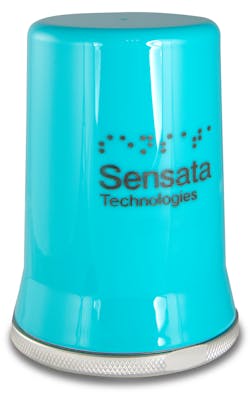Sensata Technologies has introduced the new wireless 6VW series IoT (Internet of Things) sensor designed to aid predictive maintenance of rotary assets. The sensor delivers information to the recently launched Sensata IQ platform—a cloud-based platform which uses artificial intelligence (AI) to process data from Sensata IoT devices.
According to Bryan Siafakas, director of Product Management for IoT Solutions at Sensata Technologies, only about 15% of rotary assets are currently monitored in a typical factory today. “This solution is really driving at enabling customers to monitor the remaining 85% of their plant’s assets.”
This is particularly important with the ongoing skills gap and labor shortages facing manufacturing and other industrial applications. “We're seeing a big exodus of maintenance and plant personnel who had worked [at a facility for] 30+ years that could just walk by a machine and be able to hear it and say something doesn't sound right.” Newer employees do not yet have that level of expertise.
With the 6VW sensor, manufacturers can bridge that skills gap by putting the sensor on their machines to measure vibration and acoustics to detect potential faults and optimize maintenance workflows.
A More Flexible, Reliable Wireless Sensor
The 6VW is a wireless sensor capable of operating on cellular, LTE or Wi-Fi. It is a multimodal sensor which allows collection of various data points beyond vibration due to sensor fusion onboard of several sensors, says Siafakas. The sensor is able to collect temperature, vibration and acoustics information to provide customers with a more accurate picture of the health of their machine.
Collecting acoustic information is important, says Siafakas, “because it allows you to detect some higher frequency faults such as lubrication faults which a typical vibration sensor is not able to detect.”
Essentially, a wider range of faults can be detected, and more alerts sent to the maintenance team so they can plan accordingly. The 6VW sensor can also do electrical detection, expanding upon the types of faults to which it can alert personnel.Siafakas says the sensor is easy to install; it mounts via a magnet and can be configured within 5 min. using Sensata’s mobile app. He explains that users answer a few questions during the configuration process based on information found on the motor to which the sensor is mounted.
He also notes the 6VW is a versatile solution capable of working with a range of rotating assets including fixed speed and variable speed motors, whereas other solutions are not able to work with variable speed motors.
There is a database of bearing knowledge built into Sensata’s technology as well. This includes data on the critical frequencies at which bearings operate, allowing for a higher level of confidence in predicting faults says Siafakas.
The reliability of the technology is a key feature, as well. Some industry reports have put fault characterizations at about 60% but Sensata feels its is greater than 95%. “If we say that’s a bearing fault, we’re greater than 95% confident that actually is indeed a bearing fault,” says Siafakas. “That’s really important because if you provide false alerts or notifications, the maintenance personnel are going to lose trust in the system and not use it.”
This is also beneficial for ensuring the maintenance personnel come prepared to solve the problem. If they are alerted there is a bearing fault, they can be sure to come with the right tools and spare parts to fix the problem immediately.
Sensata’s technology also notifies personnel of a component’s remaining useful life. While there may be a fault, knowing how soon that could cause a critical problem enables maintenance personnel to take appropriate action. “If it’s three months it’s not as critical as something that is going to [fail] in two days,” says Siafakas.
All of this helps to reduce unplanned downtime and improve overall equipment effectiveness.
Built-in Intelligence and Cloud Capabilities Improve Analytics
Sensata’s new 6VW sensor has intelligence and processing built into it. Siafakas says it is a hybrid of sorts as it utilizes edge computing as well as sends data to the cloud. “By default, it sends data to the cloud [about] four times a day. But if [the sensor] detects an anomaly on the edge it will upload that data to the cloud for more sophisticated analysis,” he explains.
Combining edge computing and analysis in the cloud ensures no faults are missed and the company can provide insights to customers with a high degree of confidence.
When data is sent to the cloud—the Sensata IQ platform—Siafakas says sophisticated analysis can take place to characterize and detect faults through the use of AI and machine learning. Data from other Sensata sensors can also be uploaded to easily monitor data from all of the sensors on an asset in one place.
Alerts can be sent to mobile phones and via email, making it easy for personnel to stay on top of any potential issues. These alerts are configurable, allowing users to set their own thresholds for when they would like to receive an alert.
Siafakas says the AI and machine learning within Sensata IQ—made possible through a partnership with Nanoprecise—can baseline the data it receives from the rotary asset, essentially learning what its normal operation is. And it will continue to learn over time and provide alerts about any deviation from that baseline performance.
Nanoprecise brought its experience with AI and machine learning for rotating equipment which paired well with Sensata’s sensor expertise, says Siafakas. “They really allowed us to give a high degree of accuracy of prediction of motor faults and fault characterization.”
This technology pairing allows Sensata and its customers to make sense of the sensor data—something customers were looking to get from the company—and give actionable insights to maintenance personnl.
Having the ability to analyze sensor data in the cloud is vital to ensuring a manufacturer’s uptime. “If you look at a typical manufacturer, they have about 144 unplanned downtimes a year which cost, for an average plant, about $2.3 million a year,” says Siafakas. “So, leveraging solutions like Sensata IQ and the 6VW allows customers to detect those faults before they happen and reduce the associated downtime that happens with them.”
In addition, a manufacturer can better streamline their operations and reduce maintenance costs through inventory management. Many will have backup motors sitting on a shelf in case there is a failure, and these can be expensive as well as tie up capital. With these Sensata solutions, personnel can better predict faults and when they will actually need replacement parts.
Growing Need for Digital Predictive Maintenance Tools
Siafakas says the company will continue to evolve the Sensata IQ platform with new features added for which its customers are looking.
“I absolutely see a big need in the market right now for this,” he says. Many companies still have a person coming and walking around to monitor assets, or there are assets which are not currently being monitored in real time.
There is an opportunity now to minimize or eliminate the number of manual checks on assets. Technology such as wireless sensors and connectivity has progressed, making a better case for their use in predictive maintenance. “I do see these solutions starting to disrupt that manual way of working,” says Siafakas. “I see an increasing reliance on sensors to be able to bridge the skills gap and reduce the manual walking around and report writing.”
The ability to utilize technology instead of people will be vital in the coming years to help overcome the labor shortage manufacturing is facing. Older generations are leaving the industry and fewer skilled workers are entering it, which will make it necessary for companies to find an alternative means of replacing the years of knowledge those leaving will take with them. Technologies like Sensata’s predictive maintenance solution are seen as a means of doing so.
Return on investment (ROI) will also be a key driver for the uptake of these types of solutions. Current reports show an ROI of less than one year for many of these digital predictive maintenance systems says Siafakas.
As manufacturers see the ROI and other benefits, and transition more toward Industry 4.0 and beyond, “we're going to see a large adoption of these systems in the coming years,” he concludes.




